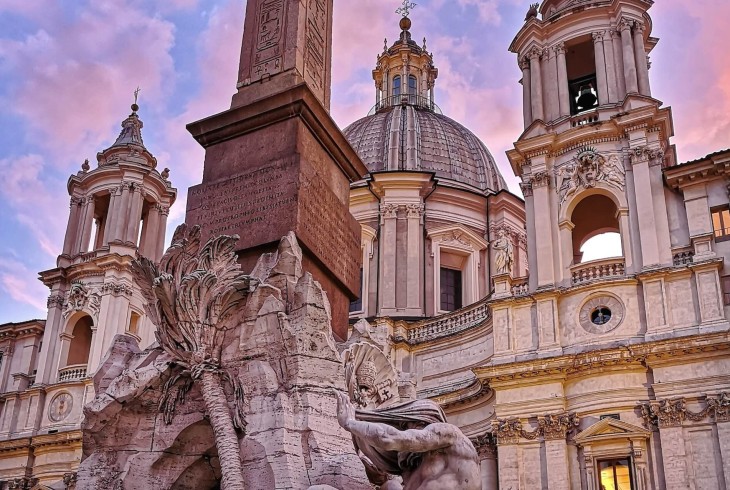Updated 6th December 2024
No trip to Rome is complete without a visit to Piazza Navona, whether it’s to admire the magnificent Baroque architecture or to pick up a souvenir in the art market. During the day, tourists and locals fill the piazza's restaurants and benches, while at night, it becomes comparatively peaceful, as you’ll discover on an evening tour of Rome.
Despite the many attractions of Piazza Navona, a beautiful square with many layers of history, it would be a shame to miss the equally charming backstreets. The Parione rione (district) of Rome, which includes Piazza Navona and the surrounding streets, has a rich and fascinating history.
Piazza Navona itself stands on the site of the Stadium of Domitian – as you sip your cappuccino in the square, imagine the athletic competitions that took place here nearly two thousand years ago. In the Middle Ages, the area was densely populated and chaotic and would have been almost unrecognizable when compared with the elegant Renaissance neighborhood we see today. Artists such as Bernini and Borromini transformed the area; these days it’s one of the most desirable places to live in the city centre.
The Top Things to Do Near Piazza Navona
Visit the Tranquil Palazzo Altemps

A fifteenth-century palazzo to the north of the piazza houses an impressive collection of classical sculptures. Palazzo Altemps is overlooked by many visitors, which is strange considering its central location.
You can admire dramatic works such as the Galatian Suicide (pictured above) or the fabulously intricate Ludovisi Sarcophagus, all while having the museum practically to yourself.
Go on the Hunt for Caravaggio

San Luigi dei Francesi, located between Piazza Navona and the Pantheon, should be on the to-do list of any art enthusiast. The church has not one but three paintings by Caravaggio – The Calling of St Matthew, The Inspiration of St Matthew, and The Martyrdom of St Matthew. For a more in-depth Caravaggio experience, join a Caravaggio in Rome tour, which includes San Luigi dei Francesi and other hidden gems in the area.
Admire Renaissance Masterpieces in Santa Maria dell'Anima
Located just 50 meters from Piazza Navona, the spectacular church of Santa Maria dell’Anima is an extraordinary treasure-trove of artistic treasures. The home of Rome’s German Catholic community for centuries, as soon as you enter this soaring basilica you are bathed in a spectacular golden light, glinting and reflecting off the gilded stucco that decorates the ceiling.
A series of exceptional Renaissance paintings and frescoes adorn the chapels; look out for the chapel dedicated to Margravi of Brandenburg, arch-nemesis of Luther, which features superb frescoes by Franceco Salviati, and the high altar itself, where Giulio Romano’s Holy Conversation is considered one of Rome’s most prized High-Renaissance paintings.
Santa Maria dell'Anima is also home to one of Rome's most spectacular Christmas cribs, which you can visit on our special Christmas in Rome tour - click the link below for more!
Escape the Crowds at the Beautiful Bramante Cloister
Donato Bramante, the architect whose rivalry with Michelangelo ignited the Renaissance in Rome, left an indelible mark on the city. Tasked with the monumental design of St. Peter’s Basilica, he also showcased his mastery with a series of breathtaking projects around the city.
One such masterpiece is the cloister attached to Santa Maria della Pace. Commissioned by the influential Cardinal Carafa, this two-story marvel features a lower level adorned with graceful Ionic columns and an upper gallery embellished with Corinthian pilasters. Bramante's genius for blending ancient architectural elements into a harmonious, luminous space is evident in every corner.
Today, this architectural gem hosts a vibrant calendar of exhibitions. The upper level houses a charming cafe, offering respite from the bustling city. While there, visitors can enjoy glimpses of Raphael's renowned Sibyl frescoes in the nearby church through a special viewing area.
Explore the Shops of Via Del Governo Vecchio
The back streets of Piazza Navona are a paradise for shoppers, as you’ll discover when you start to explore the area, whether you’re on your own or part of a Rome walking tour. Via del Governo Vecchio has plenty of boutiques and vintage clothes shops. The bookshop AltroQuando hosts live events, while Caffè Novecento is the perfect place to stop for a coffee and a cake if you need a break from browsing.
A short walk to the north takes you to Via dei Coronari, perhaps one of the most pleasant streets in Rome. Even a simple bit of window-shopping is a real pleasure, as there are so many things to see. Peer through the windows of the countless antique shops – you’re bound to find something interesting. Make sure you stop off at the famous Gelateria del Teatro, which does some of the best gelato in town. All the flavours are delicious, and you can see the gelato being made through the window.
Dolce Far Niente
The Italian expression 'dolce far niente', loosely translated as pleasant relaxation in carefree idleness, is a phrase and a way of life that many travelers to Rome should try and embrace. Rome can be exhausting if you try to plan too much, so try to leave some time to enjoy doing nothing.
Some of Rome’s most famous and characteristic cafes are located not in Piazza Navona but in the web of streets surrounding it. The historic Caffè della Pace is particularly popular with locals in an ivy-covered building on a quiet side street. Sipping a cocktail at one of the outside tables, you definitely feel like you’re living la dolce vita. For a very different vibe, head to Bar del Fico, one of the trendiest bars in the centro storico. Whether you’re looking to meet new people, enjoy some live music, or have an authentic Roman Sunday brunch, Bar del Fico has something for everyone at every time of day. If you need a coffee break, try Sant’Eustachio, which does one of the best coffees in Rome.
Have a Conversation With a Statue
Finally, here are two tips for interesting sights often overlooked. Just beyond the northeastern corner of Piazza Navona is Biblioteca Angelica, a beautiful library established in 1604, which can be visited on a guided tour. Then cross Piazza Navona and visit the tiny Piazza Pasquino, where you’ll find a talking statue. Pasquino is more than a thousand years old, and has been “talking” since the sixteenth century, when Romans began sticking satirical poems and political protests to the base of the statue.
So, after your walking tour of Piazza Navona and the city center, head to the back streets. Piazza Navona may be beautiful, but there’s so much more to discover from Caravaggio to cocktails.
~by Alexandra Turney~
For 25 years, Through Eternity have been organizing itineraries showcasing the best of Rome led by our resident expert guides. If you're planning a visit to the Eternal City this year, be sure to get in touch to help plan your perfect trip!
More From the Blog on Rome
- Everything you Need to Know About Visiting Rome
- Baroque Visions: Caravaggio, Bernini and Borromini
- 6 Most Ancient Churches in Rome
- How to visit the Colosseum in 2024: Tickets, Hours, and More
- 7 Things you Need to Know About the Trevi Fountain
- Visiting the Vatican Museums and St. Peter's Basilica: The Complete Guide
- 9 Things You Need to Know About the Pantheon in Rome
- 5 Reasons to Explore Italy with Through Eternity
- The Best Catacombs to Visit in Rome








